If someone asked me ‘which one of my journeys was the most memorable and frightening?’ I would answer: “It was the one visiting the nomadic Tsaatan tribe.”
[rpi]Hit the road with an open heart
The people of the Tsaatan tribe are the last reindeer herders in Mongolia. For thousands of years, they have lived deep in the Taiga forest, secluded in the remote Northern region of the country, with harsh climate. It is the border area between Russia and Mongolia. The Tsaatan people have maintained a nomadic lifestyle throughout their history, hardly seen anywhere else in the world today.
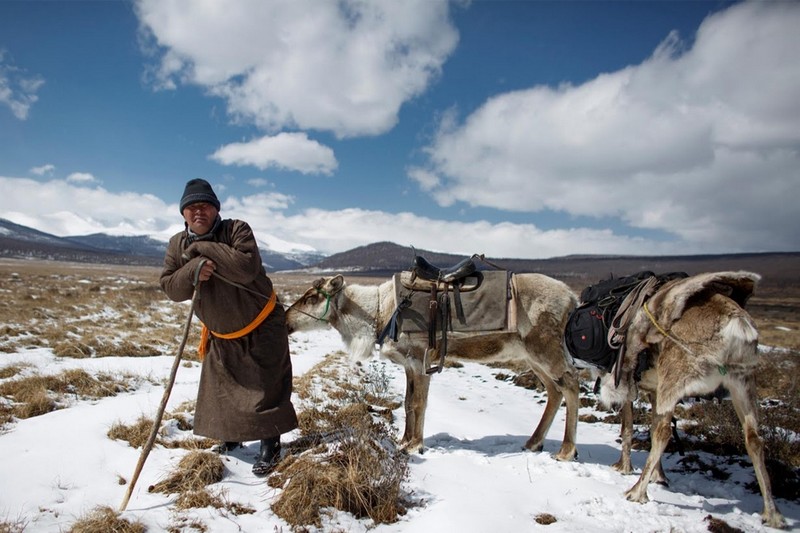
This is an interesting place, but one that does not appear on Lonely Planet’s “Must-do’s in Mongolia” list, as it’s extremely costly and difficult to reach.
You need to have an open heart to find this journey worthwhile. Leaving behind all of my preconceptions, I decided to find a way to this wilderness to satisfy my burning sense of adventure.
You can see a few huts or a few reindeer by Khuvsgul Lake in Moroon, but that is not where you can find the Tsaatan. They don’t and traditionally never have lived near Khuvsgul Lake. In recent years, a small number of Tsaatan families have moved nearer to the lake to take advantage of the tourism boom. However, this area is not a good living environment for reindeer, because there is no food and the climate is too warm for them.
Many Tsaatan people are determined to stay in the Taiga forest, where they suffer severe weather conditions in order for their reindeer to live in a good environment. I was determined to visit this place and discover this unique tribe.
An arduous journey
To visit the Tsaatan tribe, you have to take an 18-hour cramped bus ride from the capital of Ulaabaatar to Moroon, a nearly 700-kilometre journey. From Moroon, you have to take another 15-hour bus, which runs only once every few days, to travel 300 kilometres to Saganuur. Never have I endured such a terrible journey. The road was bumpy, and the bus was overloaded with goods and people, ready to break down at any moment. The first thing you should bring with you is good health.
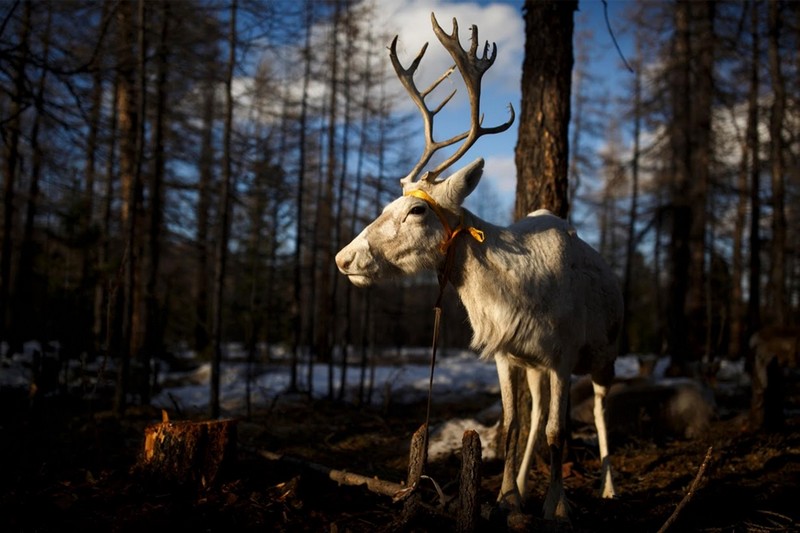
After reaching Saganuur, I asked the guide to help me obtain permission to enter the border area between Russia and Mongolia. This permission must be obtained in Moroon or Ulaanbaatar prior to your arrival. If you don’t have it, you can be fined a large amount of money.
After obtaining this permission, I was ready for the next part of the arduous journey: a long stretch on horseback, across the muddy Taiga forest to reach the Tsaatan community. If you’re not used to horseback riding, prepare for a lot of back, hip, and leg pain.
The cold in the beautiful Taiga fores
I reached the Tsaatan at the end of September. Not the ideal time to visit, as a rainy, snowy and numbingly cold morning in Saganuur awaits you. Odaa. my guide, recommended that I take a raincheck and postpone the journey for one day. “It’s raining and the snow is knee-deep and very cold. You’ll be crying when you see it,” Odaa warned me. I shook my head stubbornly: “No! I won’t cry, I want to leave today.” Odaa shrugged and introduced me to my horse. The horses were shivering from the cold, and I felt bad for them. I softly stroked a horse to comfort her.
Odaa helped me up a horse, and we started our journey from Saganuur to reach the Tsaatan. On horseback, I felt like I was lost in a fairytale. In the midst and the cold, the scenery before my eyes was magical. A woman, wearing blue traditional Mongolian clothes and a red scarf, was standing with a flock of sheep amidst the fog and the drizzling snow.
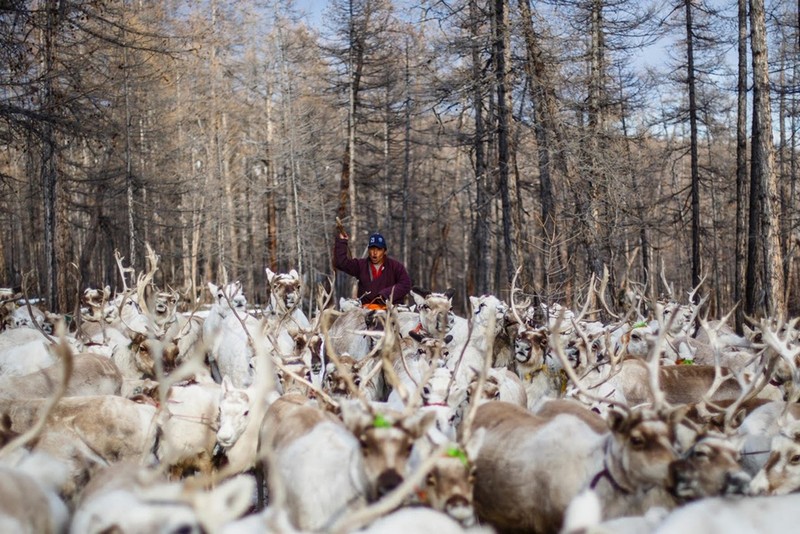
Our horses passed the sheep and entered the dark woods of the Taiga. I had never seen such a hauntingly beautiful scene. It reminded me of the landscape in the movie “Snow White and the Huntsman”. The forest was covered in fog, and the golden canopies of the pine trees were covered with snow.
Words cannot describe the beauty of nature. Despite the beautiful landscape around me, I still had to face the reality that both my horse and I were freezing and exhausted. I had been warned that it would be extremely difficult to pass through the Taiga forest. The road was covered with a layer of soft snow, underneath which was the wet mud and grass. Odaa told me that sometimes the mud is knee-deep, which means you can only travel by horse. You can hire a horse for 20,000 Mongolian Tugrik per horse per day (US$8.5) and you can hire a guide for 40,000 Tugrik per day (US$17).
I remember vividly that we were still in the woods when darkness fell. Odaa said that there were wolves roaming around the forest. At 9:30 p.m. we were engulfed in darkness and cold, which made the setting even more indescribably scary.
Odaa led the horses to turn around to find an abandoned barn on the edge of the forest. That night, we had to set up tents and sleep in the cold. It was a daunting night. The cold of the Taiga forest at night made us want to give up. Despite being exhausted, the numbing cold kept me awake. “You will freeze,” the words of warning of a friend were on repeat in my head. I was helpless in the cold night and I started to feel the frostbite. Another piece of advice: If you don’t want to sleep in the cold like we did, you should depart from Saganuur before 10 a.m.
Reaching the Tsaatan’s land
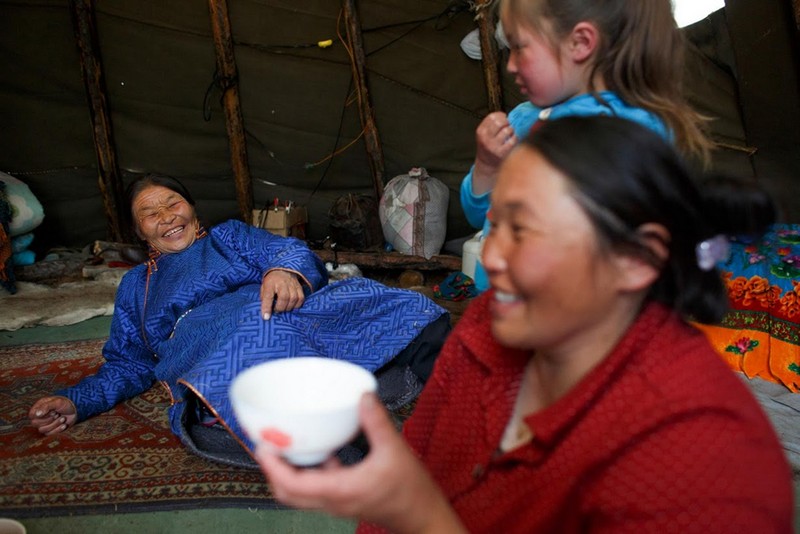
The following day, we continued the difficult journey, tired from the cold and the lack of sleep, but still determined to visit the Tsaatan tribe. We passed snowy forests, and arrived at noon. After visiting the hut of a local and enjoying some tea and bread made from reindeer milk, we rented a tepee to make our home for the next few days. The price is 10,000 Tugrik per person per day (~4usd). A tepee is a tent from ancient times, that today only the Tsaasan use. Tepees for rent are often empty, with only a stove and firewood to keep you warm from the cold of the Taiga forest.
‘Tsaatan’ in the Mongolian language literally translates to ‘those who have reindeer’, because their lives have been tied to reindeer for thousands of years. They rarely eat reindeer meat, because the milk is their main source of food. They use it every day to make tea, butter, and bread. When you’re here, you soon realise that the Tsaatan’s food is very monotonous. So my third advice to you is to bring enough food for yourself, because the Tsaatan only make enough food to sustain themselves, and do not have excess to sell or give away.
You can buy souvenirs made from reindeer horn, or you can hire a reindeer for a ride and enjoy the picturesque scenery of the snowy mountains. You can hire a reindeer for 5,000 Tugrik per reindeer per person (~2usd). It is hard if it’s your first time riding a reindeer, because their bodies are not as balanced or sturdy as a horse’s.
As a nomadic tribe, the Tsaatan relocate after every 5 to 10 weeks to find new food sources for their reindeer. In summer, when the weather is warmer, different families of a tribe stay closer together. In winter, when food sources are scarce, each family relocates to a different location, often 3 or 4 mountains apart. Thus, my forth advice to you is: if you plan on visiting the Tsaatan, it’s best for you to visit during summer so you can visit the entire tribe in one location.
If you wake up one morning to find the tepees have disappeared, do not be alarmed. This was one of the most memorable moments in my life. On the fourth day of the journey, I woke up to an empty campsite. After asking around, I came to learn that the tribe was packing up to move elsewhere for a new food source for their reindeer. If you find yourself in this situation, stay calm and call your guide, and ask him to pick you up on the same day. The Tsaatan use only one cellphone network, so even when they are up in the mountains, they can contact the outside world.
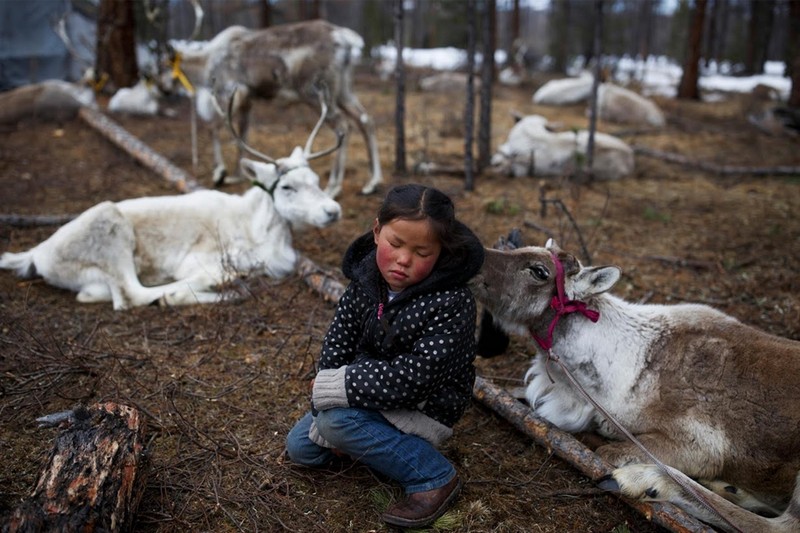
The three sleepless nights I had thanks to the cold still haunt me until this day. My last night in the Taiga, I decided to ask a Tsaatan family if I could spend the night in their tent. That night, I slept in the warmth and witnessed the everyday life of a Tsaatan family. I sat with them by the fire, ate pine nuts, and listened to their songs and stories. It was one of the best experiences I’ve ever had. Without the cold nights, I would not have had this warm and sweet evening.
A journey to visit the Tsaatan tribe is definitely not for those who look for comfort. But it is perfect for those who seek an experience, who wish to explore untouched lands and the culture of people who still live the same way their ancestors did thousands of years ago.
TIPS
Obtaining a visa to visit Mongolia
- It is not difficult to obtain a visa to enter Mongolia, but you need someone from Mongolia to send you an invitation. You can get a service, priced at US$30 – 50 per invitation. The sender will send the invitation directly to the Embassy of Mongolia in Vietnam via email. After a few days, you will get an invitation code.
- Next, you will need to prepare a 3×4 photo, your passport, invitation code, and 25usd (if you are getting your visa at the Embassy of Mongolia in Hanoi) or 40usd (if you are getting your visa at the Embassy of Mongolia in Ho Chi Minh City). You can pay by transferring the amount to the Embassy’s Vietcombank account and bringing the receipt with you to the Embassy.
- At the Embassy, you will need to fill out a form. After everything is submitted, you will get a visa within one week.
Getting there from Vietnam
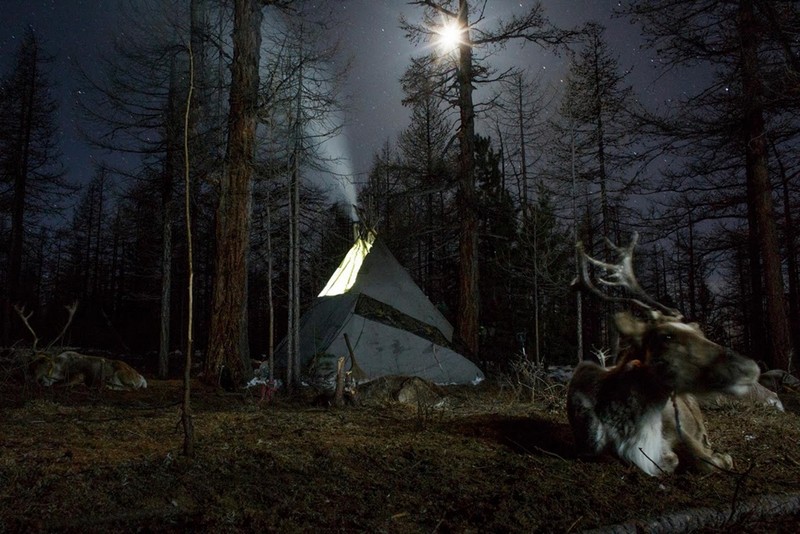
- Flying from Vietnam to Mongolia is expensive. Budget airfare ranges from 16 to 22 million VND (round trip), and you will need to transit in Hong Kong, South Korea, or China. Normally, it is cheapest to transit in Hong Kong. You can choose from airlines including Mongolia Airline, Hong Kong Airline, China Airline, and Korea Airline.
I flew with Mongolia Airlines connecting with Hong Kong Airlines, which transited in Hong Kong as that was the cheapest airfare at the time, priced at 8.5 million VND (one way). I was allowed 20 kilograms of checked baggage and 7 kilograms of carry-on. Each flight included a free meal.
What to bring?
You will need to be well-prepared for this journey, both in terms of information and things to bring: a sleeping bag, tent, waterproof boots and clothing, insulated mats, adhesive body warmers, pepper spray and food and water for a whole week.
In addition, you should find a credible guide and hire a horse. Your guide must be an experienced local, who can lead you safely, because it’s very difficult to call for help in emergencies. You have to be well prepared, and you should know that this cannot be a spontaneous journey.
Must-knows when meeting the Tsaatan
- Before taking photos, you need to introduce yourself and ask for permission. If they don’t give consent, you cannot take photos.
- When entering a local’s tepee, you should enter on the left of the entrance.
- Do not refuse tea or food when they are offered.
- Do not step over the Tsaatan’s food or belongings.
- When you sit, hide your soles; do not point your soles at others.
- Do not hand others things with your left hand.
- When you point at someone or something, your palm needs to face upward.
- Do not wash your dishes or clothing in the water source near the Tsaatan community.
- If you can afford it, hire an interpreter, because the Tsaatan believe that tourists who come with an interpreter value conversation with them, and they appreciate that. Having an interpreter will also help make communication easier for you.
Wanderlust Tips
[…] the upcoming year 2017, I plan to travel to India, Mongolia, Jordan, Morocco, and Eastern Europe. I plan to travel around India. India is such an adventurous […]